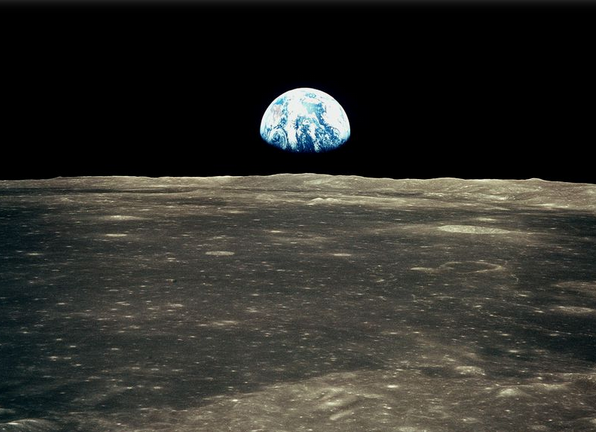The Earth as Seen from the Moon
Henrike Holdrege
From In Context #18 (Fall, 2007) | View article as PDF
I became interested in the earth as seen from the moon when I read two short paragraphs in the late Norman Davidson’s book, Sky Phenomena: A Guide to Naked-Eye Observation of the Stars. Later I learned from Annelies Davidson, Norman’s wife, that Norman felt strongly about our responsibility to imagine worlds such as the moon and Mars, where human beings had set foot or landed technical equipment. In the following short essay I attempt to paint a picture of the visual relationship of the moon and earth. All the facts mentioned can be known without traveling to the moon or making technical observations. In my reasoning I drew upon geometry and projective geometry, naked eye observations of our night sky, and studies of color phenomena following Goethe (in regard to which, see the article by Arthur Zajonc, “Toward a Participative Science.”)
The moon in its illumination by the sun appears in our night sky from month to month in phases: new, waxing, full, waning, and new again. The sun illuminates both moon and earth. And so the earth, seen from the moon, also appears in phases: full earth, waning earth, new earth, waxing earth and full earth again. When the moon is new for us, the earth is full for the moon; when the moon waxes, the earth wanes. The moon seen from the earth and the earth seen from the moon are complementary to each other: when the moon appears two-thirds illuminated, then the earth appears one-third illuminated.
Just as the moon shines onto the earth and brightens our night, the earth shines onto the moon. The earth shine is at its peak when the earth for the moon is full or almost full. We can observe this shine from down here on earth. The young crescent moon in the western sky on a clear night shows us the full moon disk: one part brightly lit by the sun, the other part, cradled in the bright crescent, dimly illuminated by the then almost full earth.
The earth, having a diameter about 3.7 times larger than the diameter of the moon, should appear in the moon sky as a disk with an area about 13 times larger than the apparent moon in our night sky. The color of this large earth is blue, blue with white patches and streaks, offering different patterns of blue and white as the earth rotates on its axis and as cloud cover on earth changes.
The moon, when rising over our horizon, often can be seen orange or red through a hazy atmosphere, like our sun at dawn and dusk. Since the moon does not have an atmosphere, there is no dawn or dusk; the sun on the moon rises and sets in a flash. Also because there is no atmosphere, the moon sky is always black and never blue. During the moon’s day, in the extremely bright sunlight that is not being diffused and softened, the moonscape has sharp black shadows and offers hardly any color. Picture now over the barren moonscape in the black sky the large earth in its beautifully refreshing and quiet colors of blue and white.
However, from only little more than one half the moon globe is the earth visible at all. That is the portion that always faces the earth, the side of the moon we see when we look up at the moon. The side that is always turned away from the earth never sees us.
The moon, seen from the earth, moves across our sky. Depending on the season, it rises somewhere between the northeast and southeast and sets between the northwest and southwest. In winter, the full moon follows an arc about as high as the sun’s arc in summer; in summer the full moon makes an arc about as low as the sun’s in winter. The earth in the moon sky, however, does not rise or set. It remains almost stationary except for a small looping movement due to the moon’s libration. Depending on the viewer’s location on the moon, the earth is either not visible at all or always positioned somewhere between close to the horizon and high in the sky.
On earth, the sun rises and sets. On the moon, it also rises and sets. On earth, the full day lasts 24 hours. On the moon, a moon day lasts much longer. From one sunrise to the next on the moon is 29.5 earth-days, a synodic month. For almost any place on the moon, the sun is up in the sky for about 15 earth-days, then down again for about 15 earth-days. The stars, too, rise and set and slowly make their arcs across the moon sky. In the black moon sky, in daylight as at night, the blue and white earth is visible in its phases relating to the sun. And the earth alone, for the moon, rests in one place in the sky, rotating on its own axis.
(See also Sky Phenomena: A Guide to Naked-Eye Observation of the Stars, by Norman Davidson. Great Barrington MA: Lindisfarne Press, 1993.)

